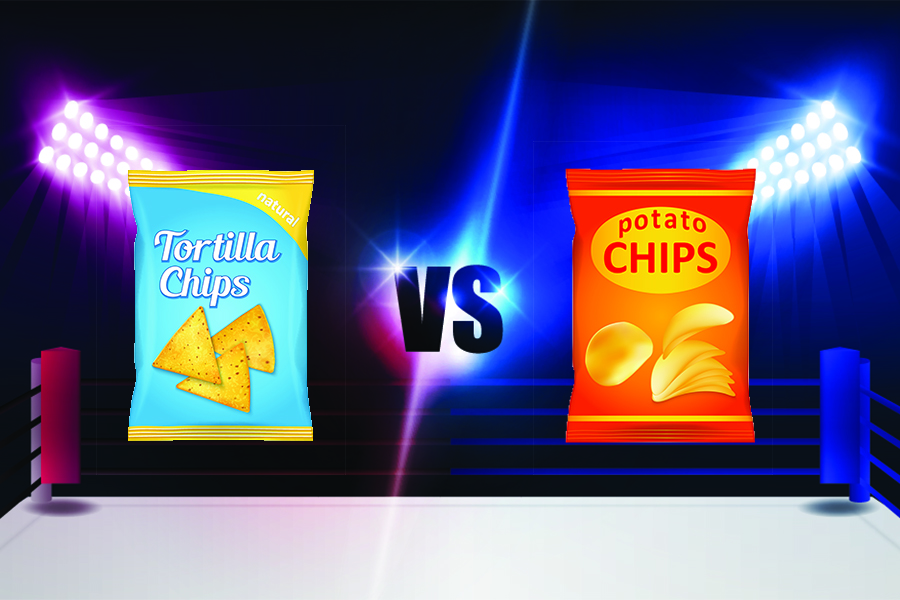Just Wondering: Are Tortilla Chips Better for You Than Potato Chips?
Alicia Romano, National Media Spokesperson for the Academy of Nutrition and Dietetics and registered dietitian at Tufts Medical Center, evaluates how these chips stack up against each other.

Photos via Getty Images/Dencake/Photoraidz
When you’re in dire need of a crunchy, salty, and delicious snack what do you reach for? If your go-to is a bag of chips, you’re not alone. You’re also not alone in thinking that reaching for tortilla chips might be a slightly healthier alternative than potato chips. But does the evidence stack up? Alicia Romano, National Media Spokesperson for the Academy of Nutrition and Dietetics and registered dietitian at Tufts Medical Center, says no.
“There really is not a tremendous difference nutritionally between standard potato chips and tortilla chips,” she explains. “Generally speaking, a one ounce serving contains about 130-150 calories, 15 grams of carbohydrates, 1-2 grams of fiber, and 6-10 grams of fat. The biggest difference is the potato versus corn base.” Which just comes down to personal preference really.
She adds that blue corn tortilla chips are slightly healthier than both potato and regular tortilla chips because they contain antioxidants from the blue corn, but the frying process may damage some of these benefits. Same with chips that have added ingredients like flax and chia seeds—while great, they are still fried snacks and should be enjoyed sparingly.
Even deeper than just tortilla versus potato though is this underlying issue that one food is “better” or “healthier” than the other. And with all the “healthy” alternatives in the grocery store, it can become even more convoluted just deciding on what snack to choose. Romano challenges this notion by arguing that everyone has their own definition of health, even going so far as to say that the word “healthy” is a loaded term. Let that one sink in for a second.
“In general, any ‘health halo’ placed on a food does not mean that it is helping your health,” she says. “Additionally, it is not teaching us about the eating experience—about mindfulness and eating appropriate portion sizes. No one should be sitting down and eating a whole bag, or pint, of anything.”
When it comes to looking for a crunchy snack she says it’s important to be mindful and intuitive of your food choices. “We are in a phase of diet culture where we are always looking for an alternative to the real thing, instead of just enjoying the real thing. This often leads to deprivation, feelings of guilt around food, and bingeing on the food we want in the first place.”
So what’s a hangry gal supposed to do when she’s hemming and hawing at the grocery store? Romano says to consider both options, or any option, and enjoy them in moderation. But if you’re looking for a snack with a crunch to replace chips for more everyday eating she says “to stick to what your craving from a taste profile and opt for something that gives you a bit more nutritional bang.” For example, some of Romano’s favorites include:
- Crunchy baked chickpeas (spice as you like)
- 1 oz. of lightly salted or spiced nuts and seeds
- Edamame dusted with sea salt and sesame
- Homemade trail mix (mixture of nuts and unsweetened dried fruit)
- Dehydrated fruit and vegetables
- Sliced fruit like apples or pears with natural nut butter
- Air popped popcorn
- Crunchy veggie sticks like carrots, celery, red peppers, snap peas, or cucumbers dipped in hummus or Greek yogurt dip
- Homemade kale chips sprinkled with your favorite spices or seasoning
The take home point is that all foods fit in a balanced eating plan, Romano says. Whether you’re a tortilla chips and salsa type of person or you prefer crunching on a salty bag of potato chips, you can let these chips fall where they may, because it really makes no difference in the grand scheme of things.


